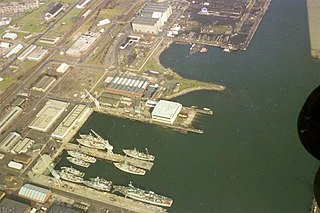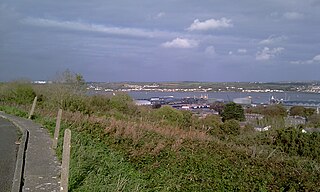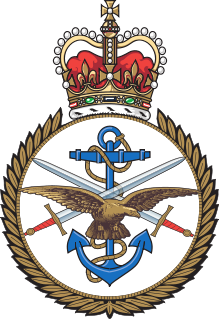
The Home Fleet was a fleet of the Royal Navy that operated from the United Kingdom's territorial waters from 1902 with intervals until 1967.

The Commander-in-Chief Fleet (CINCFLEET) was the admiral responsible for the operations of the ships, submarines and aircraft of the British Royal Navy from 1971 until April 2012. The post was subordinate to the First Sea Lord, the professional head of the Naval Service. In its last years, as the Navy shrank, more administrative responsibilities were added.

Rosyth Dockyard is a large naval dockyard on the Firth of Forth at Rosyth, Fife, Scotland, owned by Babcock Marine, which formerly undertook refitting of Royal Navy surface vessels and submarines. Before its privatisation in the 1990s it was formerly the Royal Naval Dockyard Rosyth. Its primary role now is the dismantling of decommissioned nuclear submarines. It is also the integration site for the Royal Navy's newest aircraft carriers, the Queen Elizabeth class as well as the Type 31 Frigate.

The Commander-in-Chief, The Nore, was an operational commander of the Royal Navy. His subordinate units, establishments, and staff were sometimes informally known as the Nore Station or Nore Command. The Nore is a sandbank at the mouth of the Thames Estuary and River Medway.

Pembroke Dockyard, originally called Pater Yard, is a former Royal Navy Dockyard in Pembroke Dock, Pembrokeshire, Wales.

British Forces Gibraltar is the British Armed Forces stationed in the British overseas territory of Gibraltar. Gibraltar is used primarily as a training area, thanks to its good climate and rocky terrain, and as a stopover for aircraft and ships en route to and from deployments East of Suez or Africa.
The admiral-superintendent was the Royal Navy officer in command of a larger Naval Dockyard. Portsmouth, Devonport and Chatham all had admiral-superintendents, as did some other dockyards in the United Kingdom and abroad at certain times. The admiral-superintendent usually held the rank of rear-admiral. His deputy was the captain of the dockyard.

The Commander-in-Chief, Portsmouth, was a senior commander of the Royal Navy for hundreds of years. The commanders-in-chief were based at premises in High Street, Portsmouth from the 1790s until the end of Sir Thomas Williams's tenure, his successor, Sir Philip Durham, being the first to move into Admiralty House at the Royal Navy Dockyard, where subsequent holders of the office were based until 1969. Prior to World War I the officer holder was sometimes referred to in official dispatches as the Commander-in-Chief, Spithead.

The Commander-in-Chief, Plymouth, was a senior commander of the Royal Navy for hundreds of years. Plymouth Command was a name given to the units, establishments, and staff operating under the admiral's command. Between 1845 and 1896, this office was renamed Commander-in-Chief, Devonport. The Commanders-in-Chief were based in what is now Hamoaze House, Devonport, Plymouth, from 1809 to 1934 and then at Admiralty House, Mount Wise, Devonport, from 1934 until 1996.

The Assistant Chief of the Naval Staff (A.C.N.S.) is a senior appointment in the Royal Navy usually a two-star rank and has a NATO ranking code of OF-7.

The Admiral-superintendent, Portsmouth was the Royal Navy officer in command of the Naval Dockyard. Portsmouth from 1832 to 1971; prior to this date a resident Commissioner of the Navy Board had had oversight of the yard, since 1649. In May 1971 command responsibility for naval staff in the dockyard was merged into the wider local command structure, initially under the dual designation of Flag Officer, Portsmouth and Admiral Superintendent, Portsmouth but in July 1971 was again renamed Flag Officer Spithead and Port Admiral Portsmouth after a couple of months. These joint titles was used until 1975, and despite the name change the command still covered the same geographic area and operational responsibilities until 1996 when its ceased to exist as a separate command appointment and its responsibilities were assumed by the staff of Flag Officer First Flotilla.
Naval Home Command administered training and garrison functions for the Royal Navy from 1969-2012. Its commander was Commander-in-Chief, Naval Home Command (CINCNAVHOME).
The First Flotilla was a naval formation of the British Royal Navy commanded by the Flag Officer, First Flotilla from 1971 to 1990.

The Flag Officer, Second Flotilla was a senior British Royal Navy appointment from 1971 to 1992.

The Flag Officer, Third Flotilla was the senior Royal Navy appointment in command of the Third Flotilla from 1979 to 1992.
The Flag Officer, Surface Flotilla was a senior British Royal Navy appointment from 1990 to 2002.

The Port Admiral, Portsmouth was a senior Royal Navy appointment first created in July 1971. In September 1971, all remaining flag officers in the Royal Navy holding the position of admiral superintendent at Royal Dockyards were re-designated as port admirals. This office was held jointly with the office of Flag Officer, Spithead until August 1975 when that post holders title was altered to Flag Officer, Portsmouth.

The Flag Officer Spithead was a senior Royal Navy appointment first established in July 1971. The office holder was responsible for the command of Spithead and wider Portsmouth area command, that formed a part of Naval Home Command. The appointment continued until August 1975 when it was abolished.

The Flag Officer Plymouth was a senior Royal Navy appointment first established in July 1969. The office holder was responsible for the administration of. The appointment continued until 1996 when it was abolished.








